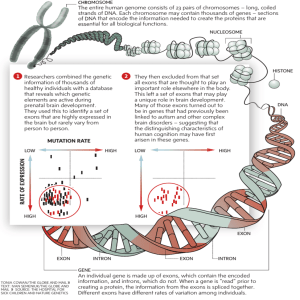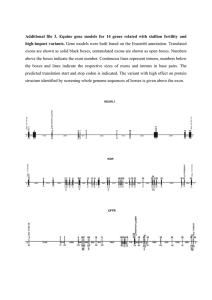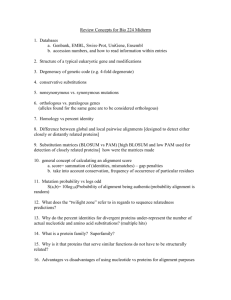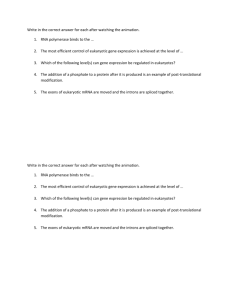Similarity-Bassed Approaches to Gene Prediction, and Spliced Alignment
advertisement
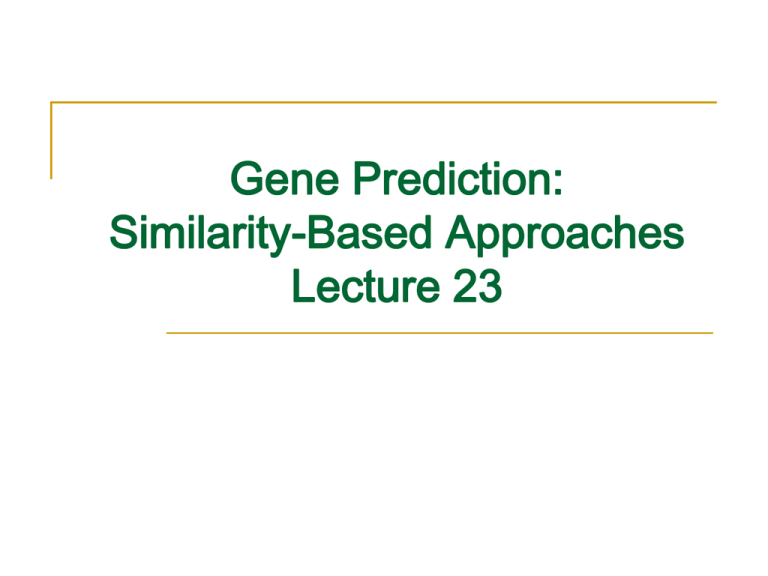
Gene Prediction:
Similarity-Based Approaches
Lecture 23
Gene Prediction:
Similarity-Based Approaches Outline
• The idea of similarity-based approach
to gene prediction
• Exon Chaining Problem
• Spliced Alignment Problem
• Gene prediction tools
Using Known Genes to Predict New Genes
• Some genomes may be very well-studied, with
many genes having been experimentally
verified.
• Closely-related organisms may have similar
genes
• Unknown genes in one species may be
compared to genes in some closely-related
species
Similarity-Based Approach to Gene Prediction
• Genes in different organisms are similar
• The similarity-based approach uses known
genes in one genome to predict (unknown)
genes in another genome
• Problem: Given a known gene and an
unannotated genome sequence, find a set of
substrings of the genomic sequence whose
concatenation best fits the gene
Comparing Genes in Two Genomes
• Small islands of similarity corresponding to
similarities between exons
Reverse Translation
• Given a known protein, find a gene in the
genome which codes for it
• One might infer the coding DNA of the given
protein by reversing the translation process
• Inexact: amino acids map to > 1 codon
• This problem is essentially reduced to an
alignment problem
Reverse Translation (cont’d)
• This reverse translation problem can be modeled as
traveling in Manhattan grid with free horizontal
jumps
• Complexity of Manhattan is n3
• Every horizontal jump models an insertion of an
intron
• Problem with this approach: would match
nucleotides pointwise and use horizontal
jumps at every opportunity
Comparing Genomic DNA Against mRNA
intron1 exon2
intron2
Portion of genome
{
{
{
{
{
mRNA
(codon sequence)
exon1
exon3
Using Similarities to Find the Exon Structure
• The known frog gene is aligned to different locations
in the human genome
• Find the “best” path to reveal the exon structure of
human gene
Frog Gene (known)
Human Genome
Finding Local Alignments
Use local alignments to find all islands of similarity
Frog Genes (known)
Human Genome
Chaining Local Alignments
• Find substrings that match a given gene sequence
(candidate exons)
• Define a candidate exons as
(l, r, w)
(left, right, weight defined as score of local alignment)
• Look for a maximum chain of substrings
• Chain: a set of non-overlapping nonadjacent
intervals.
Exon Chaining Problem
5
5
15
9
11
4
3
0 2 3
5 6
11 13
16
20
25 27 28
• Locate the beginning and end of each n
intervals (2n points)
• Find the “best” path
30
32
Exon Chaining Problem: Formulation
• Exon Chaining Problem: Given a set of
putative exons, find a maximum set of nonoverlapping putative exons
• Input: a set of weighted intervals (putative
exons)
• Output: A maximum chain of intervals from
this set
Exon Chaining Problem: Formulation
• Exon Chaining Problem: Given a set of
putative exons, find a maximum set of nonoverlapping putative exons
• Input: a set of weighted intervals (putative
exons)
• Output: A maximum chain of intervals from
this set
Would a greedy algorithm solve this problem?
Exon Chaining Problem: Graph Representation
• This problem can be solved with dynamic
programming in O(n) time.
Exon Chaining Algorithm
ExonChaining (G, n) //Graph, number of intervals
1 for i ← to 2n
2
si ← 0
3 for i ← 1 to 2n
4
if vertex vi in G corresponds to right end of the interval I
5
j ← index of vertex for left end of the interval I
6
w ← weight of the interval I
7
sj ← max {sj + w, si-1}
8 else
9
si ← si-1
10 return s2n
Exon Chaining: Deficiencies
• Poor definition of the putative exon endpoints
• Optimal chain of intervals may not correspond to any valid
alignment
• First interval may correspond to a suffix, whereas second
interval may correspond to a prefix
• Combination of such intervals is not a valid alignment
Infeasible Chains
Red local similarities form two non -overlapping
intervals but do not form a valid global alignment
Frog Genes (known)
Human Genome
Gene Prediction Analogy: Selecting Putative Exons
The cell carries DNA as a blueprint for producing proteins,
like a manufacturer carries a blueprint for producing a car.
Using Blueprint
Assembling Putative Exons
Still Assembling Putative Exons
Spliced Alignment
• Mikhail Gelfand and colleagues proposed a spliced
alignment approach of using a protein within one
genome to reconstruct the exon-intron structure of a
(related) gene in another genome.
• Begins by selecting either all putative exons between
potential acceptor and donor sites or by finding all
substrings similar to the target protein (as in the Exon
Chaining Problem).
• This set is further filtered in a such a way that attempt
to retain all true exons, with some false ones.
Spliced Alignment Problem: Formulation
• Goal: Find a chain of blocks in a genomic
sequence that best fits a target sequence
• Input: Genomic sequences G, target
sequence T, and a set of candidate exons B.
• Output: A chain of exons Γ such that the
global alignment score between Γ* and T is
maximum among all chains of blocks from B.
Γ* - concatenation of all exons from chain Γ
Lewis Carroll Example
Spliced Alignment: Idea
• Compute the best alignment between i-prefix of
genomic sequence G and j-prefix of target T:
•
S(i,j)
• But what is “i-prefix” of G?
• There may be a few i-prefixes of G depending on
which block B we are in.
Spliced Alignment: Idea
• Compute the best alignment between i-prefix of genomic
sequence G and j-prefix of target T:
•
S(i,j)
• But what is “i-prefix” of G?
• There may be a few i-prefixes of G depending on which
block B we are in.
• Compute the best alignment between i-prefix of genomic
sequence G and j-prefix of target T under the assumption
that the alignment uses the block B at position i
S(i,j,B)
Spliced Alignment Recurrence
If i is not the starting vertex of block B:
• S(i, j, B) =
max {
S(i – 1, j, B) – indel penalty
S(i, j – 1, B) – indel penalty
S(i – 1, j – 1, B) + δ(gi, tj) }
If i is the starting vertex of block B:
• S(i, j, B) =
max { S(i, j – 1, B) – indel penalty
maxall blocks B’ preceding block B S(end(B’), j, B’) – indel penalty
maxall blocks B’ preceding block B S(end(B’), j – 1, B’) + δ(gi, tj)
}
Spliced Alignment Solution
• After computing the three-dimensional table
S(i, j, B), the score of the optimal spliced
alignment is:
maxall blocks BS(end(B), length(T), B)
Spliced Alignment: Complications
• Considering multiple i-prefixes leads to slow down.
running time:
O(mn2 |B|)
where m is the target length, n is the genomic
sequence length and |B| is the number of blocks.
• A mosaic effect: short exons are easily combined
to fit any target protein
Spliced Alignment: Speedup
Spliced Alignment: Speedup
Spliced Alignment: Speedup
P(i,j)=maxall blocks B preceding position i S(end(B), j, B)
Exon Chaining vs Spliced Alignment
•
•
In Spliced Alignment, every path spells out
string obtained by concatenation of labels of
its edges. The weight of the path is defined as
optimal alignment score between
concatenated labels (blocks) and target
sequence
• Defines weight of entire path in graph, but
not the weights for individual edges.
Exon Chaining assumes the positions and weights
of exons are pre-defined
Gene Prediction: Aligning Genome vs. Genome
• Align entire human and mouse genomes
• Predict genes in both sequences
simultaneously as chains of aligned blocks
(exons)
• This approach does not assume any
annotation of either human or mouse genes.
Gene Prediction Tools
•
•
•
•
GENSCAN/Genome Scan
TwinScan
Glimmer
GenMark
The GENSCAN Algorithm
• Algorithm is based on probabilistic model of gene structure
similar to Hidden Markov Models (HMMs).
• GENSCAN uses a training set in order to estimate the
HMM parameters, then the algorithm returns the exon
structure using maximum likelihood approach standard
to many HMM algorithms (Viterbi algorithm).
• Biological input: Codon bias in coding regions, gene
structure (start and stop codons, typical exon and
intron length, presence of promoters, presence of
genes on both strands, etc)
• Covers cases where input sequence contains no
gene, partial gene, complete gene, multiple genes.
GENSCAN Limitations
• Does not use similarity search to predict
genes.
• Does not address alternative splicing.
• Could combine two exons from
consecutive genes together
GenomeScan
• Incorporates similarity information into
GENSCAN: predicts gene structure which
corresponds to maximum probability conditional
on similarity information
• Algorithm is a combination of two sources of information
• Probabilistic models of exons-introns
• Sequence similarity information
TwinScan
• Aligns two sequences and marks each base
as gap ( - ), mismatch (:), match (|), resulting
in a new alphabet of 12 letters: Σ {A-, A:, A |,
C-, C:, C |, G-, G:, G |, T-, T:, T|}.
• Run Viterbi algorithm using emissions ek(b)
where b ∊ {A-, A:, A|, …, T|}.
http://www.standford.edu/class/cs262/
Spring2003/Notes/ln10.pdf
TwinScan (cont’d)
• The emission probabilities are estimated from
from human/mouse gene pairs.
• Ex. eI(x|) < eE(x|) since matches are
favored in exons, and eI(x-) > eE(x-) since
gaps (as well as mismatches) are favored
in introns.
• Compensates for dominant occurrence of
poly-A region in introns
Glimmer
• Gene Locator and Interpolated Markov ModelER
• Finds genes in bacterial DNA
• Uses interpolated Markov Models
The Glimmer Algorithm
• Made of 2 programs
• BuildIMM
• Takes sequences as input and outputs the
Interpolated Markov Models (IMMs)
• Glimmer
• Takes IMMs and outputs all candidate genes
• Automatically resolves overlapping genes by
choosing one, hence limited
• Marks “suspected to truly overlap” genes for
closer inspection by user
GenMark
• Based on non-stationary Markov chain models
• Results displayed graphically with coding vs.
noncoding probability dependent on position in
nucleotide sequence
